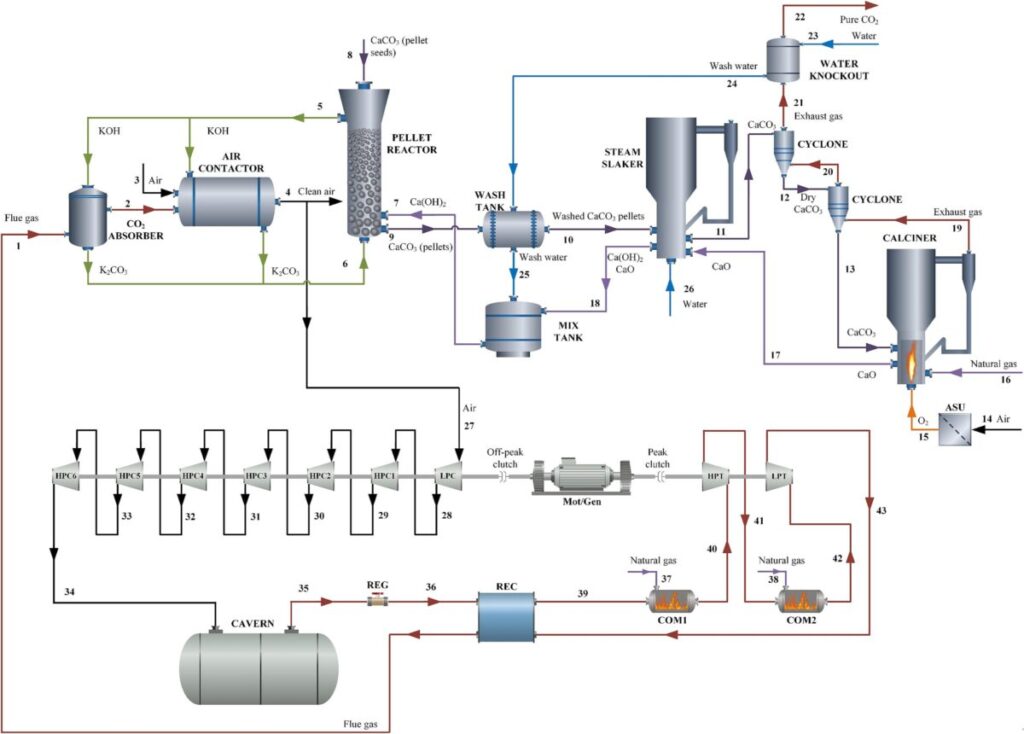Scientists in China have simulated a system that combines liquid -based direct aerial replacement with diabatic compressed air energy storage, for both processes. They explore the economic feasibility and discovered that the system could reach a level of $ 0.53/kWh energy and a level of CO2 level laid down from the air of $ 259/TCO2.
A research group led by Chinese East China University of Science and Technology and Tongji University has proposed a new system that integrates liquid-based direct aviation (L-DAC) with diabatic compressed air storage (D-CAEs).
‘Previous studies were aimed at integrating CAES with carbon capture after the burning. Linking L-DAC with D-CAEs, especially with the help of solvent-based recording for both atmospheric and point-source CO2 is never investigated and offers a groundbreaking framework for storage of sustainable energy, ”said the corresponding author, Yuxing Ding, told PV -Magazine.
“DAC is an important removal of carbon dioxide with various benefits. An important advantage is the ability to capture CO2 directly from the air instead of Point sources such as power plants or industrial facilities, ”the group explained. “Integrating DAC with D-CAEs offers various benefits. Firstly, DAC can offer a source of CO2 for the D-CAES system, which can improve the efficiency of the system by increasing the mass flow speed of the work fluid. This can improve the overall performance of the D-CAES system and increase its energy storage capacity. “
In addition, the team emphasized that integrating DAC with D-CAEs to help reduce the overall CO2 footprint of the system by conquering and storing CO2 emissions from the air. The D-CAEs emit CO2 by releasing air from storage through burning, usually with natural gas or fuel. “This emission forms a considerable environment -which requires a further CO2 recording process to reduce the impact of climate change,” the academics said.
The academics simulated the system in the Aspen Plus software to optimize it and assesses its technical and commercial feasibility. In the simulation, the D-CAES system compresses clean air from the DAC system during periods of low energy demand, stores in underground caves and releases when the demand for electricity is high. The compressed air is expanded by an expander and drives a generator to produce electricity. The L-DAC side of the system, on the other hand, floats in GAS-liquid in contact with a sprayed aqueous alkaline solution. The CO2 responds with the alkaline solution to produce a carbonate solution that has been knocked down in fixed carbonates.
Image: East China University of Science and Technology, Energy Conversion and Management: X, CC by 4.0
The L-DAC process was modeled in a continuous flow chart that includes the K-cycle and CA cycle and appeared to catch 1 MT CO2 of the atmosphere and ultimately to deliver 1.48 MT Dry CO2 annually. In their modeling, the scientists assumed that the standard air composition is 78% nitrogen, 21% oxygen and 1% argon, where other gases are ignored in a small part. They also assumed that the isentopic efficiency of the multi-phase compressors was 75%, and the inlet temperature of the natural gas was 32 ° C. The pressure at the inlet of the combustion chamber was assumed to be the same as the exhaust pressure of the cave.
According to their simulation results, the return efficiency (RTE) of the D-CAES system can reach up to 59.27%, which provides 206 MW of electrical energy. On the L-DAC system, with an air travel distance (ATD) of 12 m, a CO2 catch speed of more than 90% is feasible. “However, increasing ATD beyond this point does not significantly increase the catch speed,” the researchers emphasized.
Moreover, the group has also carried out an economic analysis of the system. It assumed that the Capex would be $ 1,118 million for the integrated system, including $ 879 million for L-DAC and $ 239 million for D-CAEs. The annual fixed OPEX was supposed to be 3.7% of the Capex.
“The economic analysis reveals legal energy costs (LCOE) of 0.53 $/kWh for the D-CAES system, while the level of the Air level is set at 259 $/TCO2,” the scientists concluded. “Although the integrated system does not offer substantial cost benefits, it is crucial for promoting low -carbon energy systems. This study is a basis for the environmentally friendly sustainable commercial implementation of D-CAES systems. “
Their findings were presented in “An integrated solution to reduce climate change due to direct aerial capture and diabatic compressed air energy storage“Published in Energy conversion and management: X.
This content is protected by copyright and may not be reused. If you want to work with us and reuse part of our content, please contact: editors@pv-magazine.com.
Popular content


